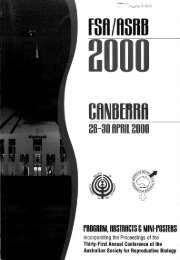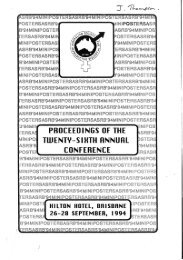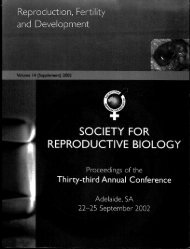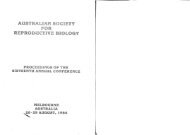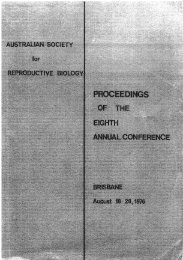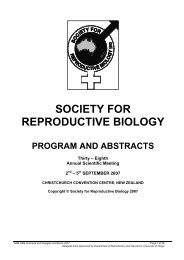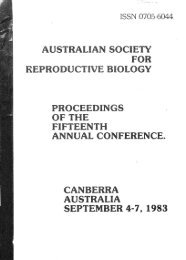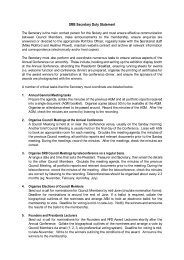N OCIETY' - the Society for Reproductive Biology
N OCIETY' - the Society for Reproductive Biology
N OCIETY' - the Society for Reproductive Biology
You also want an ePaper? Increase the reach of your titles
YUMPU automatically turns print PDFs into web optimized ePapers that Google loves.
EMBRYONIC STEM CELL LINE PLAYS THE MOST IMPORTANT ROLE IN THEPRODUCfION OFGERMLINE CIDMAERAS .RuiIi Li, Ian Lyons, Richard Harvey, Lorraine Robb.The Walter and Eliza Hall Institute ofMedical Research, P.O, Royal Melbourne HospitalVictoria 3050 .Introduction The isolation of embryonfc stem (ES) cells from mouse blastocysts has proved avaluable tool <strong>for</strong> research into gene function, gene regulation and developmental biology. Amajor advantage of ES cells is <strong>the</strong> capacity of ES cells to be precisely manipulated at <strong>the</strong>molecular level in vitro and to integrate into <strong>the</strong> host embryo in vivo <strong>the</strong>re by giving rise tochimaeric offspring. These offspring can produce ES cell-derived germ cells enabling <strong>the</strong>breeding of mouse strains homozygous <strong>for</strong> a gene alteration (germline chimaeras). An importantaspect of gene targeting using ES cells is <strong>the</strong> efficient production of germline chimaeras. Wereport here <strong>the</strong> factors affecting <strong>the</strong> production of germline chimaeras, which we have measuredin our gene targeting studies.Materials and Methods 1. Effect of <strong>the</strong> source of host embryos on <strong>the</strong> chimaera production:Blastocysts from BALB/c and C57BIIKa mice which were ei<strong>the</strong>r superovulated or naturallymated were used as host embryos. Ten to 15 ES cells (CCE) were inj ected into blastocysts whichwere transferred to pseudopregnant mice. 2. Chimaera production by morulae aggregation orblastocyst injection of ES cells. Embryos (F2: C57B1I6 x C57Bl/10) at morula stage and atblastocyst stage were aggregated and injected with ES cells (E14) respectively. Subsequentchimaera production was examined. 3. The effect of different ES cell lines on <strong>the</strong> production ofgermline chimaeras. Six well established ES cell lines were cultured and inj ected into blastocysts(F2). The production of germline chimaeras was examined by GPI (glucose phosphateisomerase) analysis of sperm (Mann et.a!., 1993).Results A higher number of chimaeras wasproduced when host embryos were fromsuperovulated C57BIIKa compared withBALB/c mice. Superovulation did not affectchimaera production ofbIastocysts injected withES cells, instead, it was superior than naturalmating in certain mouse strains. More pupswere born and a higher percentage of chimaeraswas produced in blastocyst inj ection comparedto morula aggregation (70% vs 17 % ) of EScells. Different ES cell lines gave rise todifferent production of germline chimaeraswhen <strong>the</strong>y were injected into blastocyst (Fig. 1).Fig. 1: Germllne Chimaeras of ES Cell Lines• CCE2d E141m W9.S~ R1[:J D3II J1.1Discussion. These studies show that superovulation is an effective way to supply embryos <strong>for</strong>chimaera production. Morula aggregation of ES cells can produce chimaeras but <strong>the</strong> yield islower when compared to blastocyst injection ofES cells. When an ES cell line is used <strong>for</strong> genetargeting, it is always advisable to test <strong>the</strong> production of germline chimaeras of <strong>the</strong> cell lines,although <strong>the</strong>se ES cell lines had demonstrated production ofgermline chimaeras elsewhere.0/010080604020o L-......J~~..JIllL.__~a...L-=-Cb Im a eLa s Germlin e Chimaer asESTABLISHMENT OF A SLA :(NBRED MINIATURE PIG HERD FREE OFQUARANTINE RESTRICTIONSJ.J. Arlaud a , L. Baker a , R.L. Williams a , C. P. Cunningham b , I.M. Lewis a , W.G. Browne,M. BorgC, D. Kerton C and AJ. French aaCentre <strong>for</strong> Early Human Development, Institute of Reproduction and Development, Monash University,VIC, 3168 .bSchool of Veterinary Science, University of Melbourne, Parkville, 3052CPig Research and Training Centre, Victorian Institute of Animal Science, Werribee, 3030The inbred SLA miniature pig was developed by selective breeding to create a genetically definedanimal, homozygous <strong>for</strong> an allele of <strong>the</strong> major histocompatibility locus (MHC) (1). We maintain asmall colony of inbred SLA miniature pigs in quarantine to allow studies in <strong>the</strong> field ofxenotransplantation.To allow expansion of <strong>the</strong> herd and removal of quarantine restrictions, a new miniature pig herd wasinitiated via embryo transfer using first and second generation offspring bred from <strong>the</strong> originalsixteen imported founding animals. Estrous synchronization and superovulation of donor sows wasattained using a previously described protocol (2). Briefly, donor sows (>190 days old), mated ondetected estrus and confirmed pregnant by non return to estrus (days 18-22) and ultrasound (days21-35), were aborted by two prostaglandin (PG, Juramate, Jurox Pty. Ltd.) injections (1.0 & 0.5 mg)24 h apart, and superovulated with 1000 iu eCG (Folligon, Intervet (Aust) Pty. Ltd.). The eCG wasgiven simultaneously with second PG treatment. Ovulation was synchronized 72 h after eCG with500 iu hCG (Chorulon, Intervet (Aust) Pty. Ltd.). Donors were mated twice approximately 32 h and49 h after hCG. Day 3 (4-8 cell embryos) were collected under anaes<strong>the</strong>sia using a Foley ca<strong>the</strong>ter(16-18 Fr) from <strong>the</strong> upper two thirds of each uterine hom. Zona intact embryos were repeatedlywashed (lOx) in fresh media and treated with 0.25% trypsin (60-90 s) to remove infectious agentsaccording to lETS guidelines (3.). Outbred commercial recipients (Large WhitelLandrace) weresynchronized 24 h behind that of donors by injection of 1000 iu of eCG (Folligon, Intervet (Aust)Pty. Ltd.) 24 h after weaning and a fur<strong>the</strong>r injection of 500 iu hCG (Chorulon, Intervet (Aust) Pty.Ltd.) 73 h after eCG. Recipients were selected <strong>for</strong> embryo transfer following detection of standingheat (24 h post hCG). Embryos were surgically transferred to recipients two days after heatdetection.One hundred and <strong>for</strong>ty four embryos were collected from 21 donors (Avg. 6.9 embryos/donor) andtransferred to nine outbred commercial recipients. Five recipients farrowed 21 live piglets. Of <strong>the</strong> 21piglets born 16 are currently being used to fur<strong>the</strong>r expand <strong>the</strong> new herd. Comparison between birthweights of SLA miniature pigs born and suckled on SLA miniature sows and recipients (LargeWhitelLandrace) are currently being examined.1. Sach, D.H.,Leight, G., Cone, J., Schwarz, S., Stuart, L., and Rosenberg, S., (1976) Transplantation22(6):559-5672. Arlaud, J., Williams, R.L., Michalska, A.E., and French, AJ., (1998) Proc. Aust. Soc. Reprod. Biol. 29:19(abst.)3. Manual of <strong>the</strong> International Embryo Transfer <strong>Society</strong> (1990) (Eds. Stringfellow, D.A. and Seidel, S.M.,)Champaign IL, USAReferencesMann GB, Fowler KJ, Grail D, Dunn AR. (1993). Identification of germ-line chimaeras by polymerasechain reaction and isoenzyme analysis ofmouse spermatozoa.). Reprod. Fertil. 99: 505-512.126127



